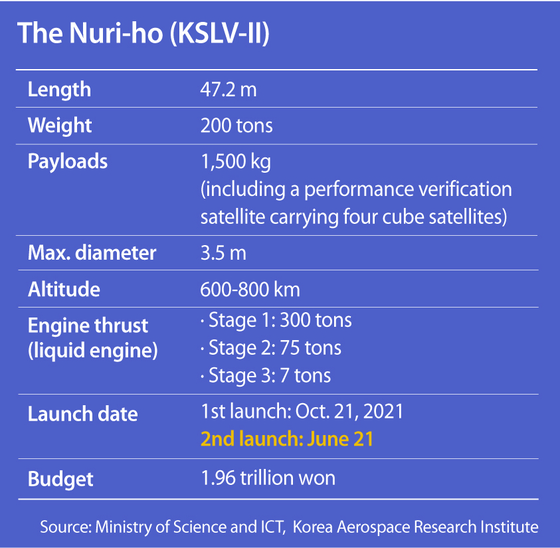Korea enters space club with successful launch of Nuri
![Korea Space Launch Vehicle-II, or Nuri, takes off from the Naro Space Center in Goheung County, South Jeolla, Tuesday. [MINISTRY OF SCIENCE AND ICT]](https://koreajoongangdaily.joins.com/data/photo/2022/06/22/23b7a155-9f87-4982-b1f7-77a37a3a0acd.jpg)
Korea Space Launch Vehicle-II, or Nuri, takes off from the Naro Space Center in Goheung County, South Jeolla, Tuesday. [MINISTRY OF SCIENCE AND ICT]
GOHEUNG, South Jeolla — Korea successfully launched a satellite into orbit on Nuri, a domestically-developed rocket, on Tuesday.
It is "a major milestone not for only Korea's scientific and technological advancement but also the country's history as a whole," said Science and ICT Minister Lee Jong-ho during a press briefing at the Naro Space Center in Goheung County, South Jeolla.
"Korea's path to space is now clear," said Lee.
President Yoon Suk-yeol watched the launch from the presidential office in Seoul, pledging to actively support the space industry and establish an aerospace agency, as he promised during the election campaign.
"The launch of Nuri is the result of hard work over the past 30 years," Yoon said.
With the successful launch of the Korea Space Launch Vehicle-II (KSLV-II), named Nuri, Korea Aerospace Research Institute (KARI) became the seventh space agency to succeed in putting a satellite weighing more than 1 ton into space, following Russia, the United States, the European Union, China, Japan and India.

The three-stage, liquid-fueled Nuri rocket blasted off from the launch pad with a thundering roar at 4 p.m., on time, carrying a 1,500-kilogram payload, including a performance verification satellite, four cube satellites (CubeSat) and a dummy payload. The small-sized CubeSats are placed inside the performance verification satellite.
The ground control center erupted with cheer and applause when it was confirmed that the rocket reached the targeted altitude of 700 kilometers and the payloads separated from booster.
"Nuri, which was launched at 16:00 on June 21, 2022, reached the targeted orbit, separated the performance verification satellite successfully and settled it into orbit," Lee said.
The first stage booster, fitted with four 75-ton liquid fuel engines, separated 123 seconds after the launch at an altitude of 62 kilometers. A cover surrounding the payloads was split off after 227 seconds at an altitude of 202 kilometers.
When 269 seconds passed, the second-stage booster, equipped with a 75-ton liquid fuel engine, was separated at an altitude of 273 kilometers.
The third stage booster and the payloads separated 875 seconds after liftoff, at the targeted altitude of 700 kilometers.
And the dummy payload separated from the performance verification satellite after 945 seconds, 15 minutes and 45 seconds after the launch.
The entire flight took 14 minutes and 35 seconds, 22 seconds short of the expected 897 seconds, but the mission was a success regardless.
The launch sequence proceeded a little faster than the original plan due to a minute difference in the performance of the booster engine, according to KARI.
The performance verification satellite — which verifies the performance during the launch and separation process — communicated with Korea's Antarctic King Sejong Station at 4:42 p.m. as planned, KARI said, confirming that the satellite has been put into orbit.
This was Korea's second attempt to fire its own rocket into space, following the first trial on Oct. 21, 2021.
Unlike the first trial, which ended in partial success with the rocket's dummy payloads failing to stay in the targeted orbit, Nuri was able to put actual satellites into the right orbit this time.
The cube-shaped performance verification satellite, measuring 1 meter in width, length and height, was developed by Seoul-based Asia Pacific Satellite and will circle the orbit for two years.
The four CubeSats inside the performance verification satellite will be rolled out from the satellite one at a time, with a two-day gap between each, starting from June 29.
Chosun University's STEP Cube Lab-II CubeSat will be split from the performance verification satellite on June 29, which is eight days after the launch, followed by KAIST's Randev, SNU's Snuglite-II, and Yonsei University's Miman.
The CubeSats will carry out missions for about six months to a year, and whether the satellites are successfully put into orbit will be determined after they are separated from the performance verification satellite over the next two weeks.
During the first launch last October, the dummy payload failed to stay in the targeted orbit due to a technical glitch in the third-stage booster despite a successful lift-off and payload separation. The technical glitch was caused by a malfunction in the third-stage oxidizer tank that led to the engine burning 46 seconds less than planned.
The preparation for the second launch was not without hitches. The launch was rescheduled twice from the originally designated date of June 15: first by a day to last Thursday due to weather conditions, and then to Tuesday due to technical glitches.
A malfunction in a sensor in a first-stage oxidizer tank, which was found last Wednesday during a pre-launch check, was fixed by Friday.
Korea funneled about 1.96 trillion won ($1.5 billion) into the space project to launch its domestically-developed rocket since 2010. Local engineers had to borrow Russian technology to launch the KSLV-I, Nuri's predecessor, in 2013.
KSLV-II rockets will be launched into space four times more through 2027.
The third launch of a KSLV-II is slated for early next year. The rocket will be carrying a 100-kilogram next-generation small satellite developed by KAIST.
The Korea Space Launch Vehicle Advance Project, which will run from 2022 through 2027, is currently underway, with an estimated budget of 687.4 billion won. Korea will launch its first lunar orbiter in August.
BY SHIN HA-NEE [shin.hanee@joongang.co.kr]










with the Korea JoongAng Daily
To write comments, please log in to one of the accounts.
Standards Board Policy (0/250자)